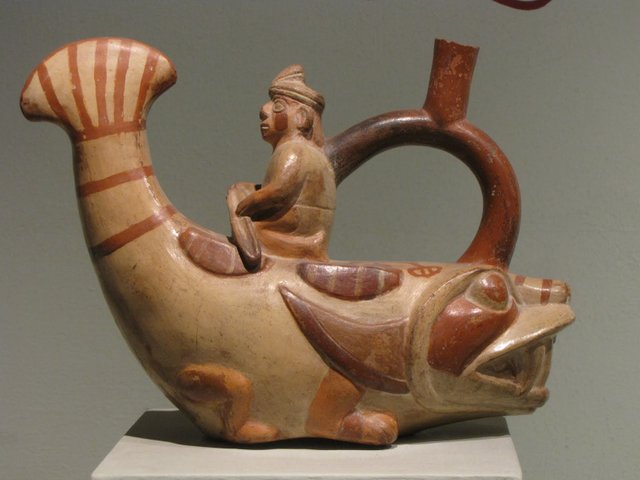MOCHE CIVILIZATION, AN AMAZING CULTURE

The Moche civilization (also known as the Mochica) flourished on the north coast and valleys of ancient Peru, particularly in the valleys of Trujillo and Chicama between 1 CE and 800 CE. The Moche state eventually spread covering an area of the Huarmey Valley in the south of the Piura Valley in the north, and did not even extend its influence from places as far away as the Chincha Islands. Territory Moche was divided linguistically by two distinct but related languages: Muchic (spoken north of the Lambayeque Valley) and Quingan. The two areas also show slightly different artistic and architectural trends and thus the Moche state can best be described as a loose Confederation rather than a unified entity.
The Moches were contemporaries with the Nazca civilization (200 BC - 600 CE) longest on the coast but, thanks to their conquest of surrounding territories, they were able to accumulate the wealth and power necessary to establish themselves as one of the most important and unique early-Andean cultures. The Moches were also expressed in art with such a high degree of aesthetics that their naturalistic and vibrant murals, ceramics and goldsmithing are among the most respected in the Americas.
MOCHE
The capital, known simply as Moche and giving its name to the civilization it founded, is located at the foot of the Cerro Blanco mountain and once covered an area of 300 hectares. In addition to urban housing, plazas, warehouses and workshop buildings, it also has impressive monuments that include two mounds of massive adobe brick pyramidal. These monumental structures, in their original state, show typical features of Moche architecture: multiple levels, access ramps and sloping roofs.

The largest 'pyramid' is the Huaca del Sol, which has four levels and is now 40 meters high. Originally it stood more than 50 m high, covered an area of 340 x 160 m and was built with bricks over 140 million, each stamped with the mark of a creator. A ramp on the north side gives access to the summit, which is a platform in the shape of a cross. The smallest structure, known as the Huaca de la Luna, is 500 meters away and was built with some 50 million adobe bricks. It has three levels and is decorated with friezes show rituals and Mochica mythology. The entire structure was once included within a high adobe brick wall. Both pyramids were built around 450 CE, originally they were brilliantly colored in red, white, yellow and black and were used as imposing an adjustment to perform rituals and ceremonies. The Spanish conquistadors then diverted the Moche River to decompose the Huaca del Sol and loot the tombs inside, suggesting that the pyramid was also used by the Moche for generations as a Mausoleum for important people.
MOCHIC ART
Many examples of Mochica art have been recovered from the tombs of Sipán (c. 300 CE), San José de Moro (c. 550 CE) and Huaca Cao Viejo, which are conserved among some of the best burial sites of any Andean culture. . The Moche were talented potters and magnificent metallurgists, and findings include exquisite gold headdresses and breastplates, gold, silver and turquoise jewelry (especially earmuffs and nose ornaments), textiles, tumi knives and copper bowls and vases. to drink. Fine ceramic vessels were generally made using molds, but were individually and distinctly decorated, typically using cream, reds and browns. Perhaps the most famous vases are the highly realistic portrait stirrup-gushing pots. These are considered portraits of real people, and several examples representing the same individual could be made. Indeed a face - easily identified by its cut lip - appears in more than 40 these pots.
Decorations and ceramic forms evolve over time and became increasingly elaborate, though on the contrary, subjects became less various in later Moche ceramics and art in general. One of the most distinctive styles created by the Moche uses figures of silhouette adorned with details of fine line very similar to the Greek ceramics of black figures. Effigy ceramic figures are also common, especially of musicians, priestesses and captives.

This post has received a 9.94% upvote from thanks to: @aldahyr77.
thanks to: @aldahyr77.
For more information, click here!!!!
If you use our Robot before your post has 1 day and get an Upvote greater than 1%, you will automatically receive Upvotes between 1% and 10% as a bonus from our other robots.
Help support @minnowhelper and the bot tracker by voting for @yabapmatt for Steem witness! To vote, click the button below or go to https://steemit.com/~witnesses and find @yabapmatt in the list and click the upvote icon. Thank you.
Voting for @yabapmatt